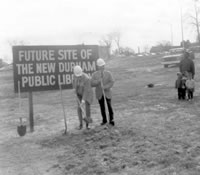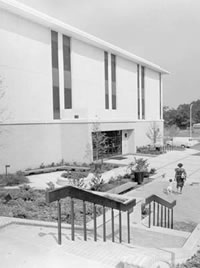This History of Public Library Service in Durham, 1897-1997 by Jessica Harland-Jacobs
The Durham County Library: Free and Open to All
On March 18, 1980 the Durham Herald reported After 59 years in genteel quarters on Main Street that eventually grew shabby, Durham County's downtown library officially moved Monday into the soothing spaciousness of its new home on North Roxboro Street.
[124]
Compared to the 5,400-square foot building it replaced, the new facility indeed conveyed a sense of openness and possibility with its 65,000 square feet, ten foot high ceilings, and various rooms built for specific purposes.
In addition to a Children's Room, an Audio-Visual Room, and capacious office and work space, the new library boasted the North Carolina Room. This area had received special attention: walnut-finished paneling, brass-grilled book cabinets, and a tiled ceiling. It enabled the library finally to consolidate the collection of materials relating to North Carolina and works by North Carolina authors that had started with Julian Carr's donations beginning in 1897. Linder had gone out of his way to nurture this and the Negro Collection by visiting used book stores across the state.[125] In a portrait depicting the benefactor in uniform, Carr oversees the use of the room. His position there is appropriate--he had requested that instead of buying flowers for his funeral, people donate books to the library. In 1982 the room was named in honor of Benjamin Powell, who had served on the Board of Trustees for twenty years and persisted throughout this period of difficulty and frustration to bring to fruition the dream of a new downtown public library facility.
[126]
With his goal of building a new, integrated library for Durham finally accomplished, Linder retired in early 1982. He had been suffering from poor health for a number of years. In April Dale Gaddis became the fifth director in the library's history. Like the librarians who came before her, Gaddis faced the complex issue of Durham's racial divisiveness. But her experience differed insofar as she was the first director to oversee an integrated system upon taking charge. At the very least she could provide a facility that Durham's diverse communities could share and use as a meeting place.
One of the first issues that Gaddis had to deal with was the future of the Stanford L. Warren Branch. The combined factors of downtown redevelopment, the merger, and the movement of population away from the city center meant that the branch suffered from a seriously reduced patron base during the sixties and seventies. The opening of the new main library within two miles of the branch struck another blow. Between 1979 and 1981, users dropped thirteen percent and circulation declined by over a third. Circulation of children's books was cut in half.
Moreover, the building did not receive sufficient attention during the seventies. Its signs were defaced, its lawn worn, and its parking lot overgrown with weeds.[127] Having learned that one of the prices of integration was usually the closing of black institutions, members of the African American community feared that the branch would be closed. Library administrators did not want to close the branch unless the impetus to do so came from within the African American community itself.[128] Both groups agreed they needed to rethink the branch's mission and revitalize its role in the community.
To address these problems and make a plan for action, the Board appointed a committee in the fall Of 1983. Headed by Constance Watts (granddaughter of Aaron Moore and John Merrick), the team sought to analyze use trends and changes in the branch community and to identify maintenance and design problems of the branch facility.
[129] The first step was to conduct a demographic study, which determined that the community was composed of a significant proportion of children; that the majority of adults were women who worked during the day and had great need for daycare; that the population as a whole was at a low educational level and experienced high unemployment; and finally that the percentage of senior citizens was on the rise.
Once they analyzed the community and its needs, the team then held a series of four public meetings to provide a forum for the expression of views, concerns, and ideas. The community hearings were well attended, fostered enthusiastic discussion, and resulted in the decision to establish a Friends of the Library association. The community indicated that it prized the Negro Collection at the branch, but resisted the idea of turning the branch into an African American resource center. With these suggestions in mind, the team recommended renovations for the building and a facelift for the exterior, the nurturing of contacts with the community and improved public awareness of the library's offerings, and the dramatic expansion of children's services.[130] For adults, the study recommended improving the book collection, publicizing the Negro Collection, and setting up a resource center for information on employment, continuing education, job training, and human services.
With the study in hand, the Friends of the Stanford L. Warren Branch Library and the library administration approached county officials about providing funds for renovations. The county government, in a cooperative mood, agreed and renovations proceeded in 1984 and 1985 at a cost of $245,000.[131] The Stanford L. Warren Branch Library re-opened its doors in November 1985 and under the leadership of Shirley Brown renewed its programs and services, including the Early Childhood Learning Resource Center, the Homework Hotline, and Community Information Area.

Breaking ground for the new library on Roxboro Road, 1979.
Since its opening in 1980, the main library has offered a wide range of programs that would have been impossible to provide in the old library. Programs for children included Reading Is Fundamental (RIF), summer reading clubs, and Magic Tree. Patrons of all ages benefited from the dramatically expanded audio-visual services department in the new library. For adults the library offered an in-depth business reference collection, Project LIFT, and voter registration, among other services.
In addition to permanent services, the library has presented special programs. For example, the library worked with Judith Ruderman of Duke's Office of Continuing Education to hold several series of lectures, courses, and films funded by grants from the North Carolina Humanities Committee. Emphasizing literature, history and diversity with programs such as The Many Faces of Bloomsbury,
The New Negro Renaissance,
and South of Hester Street,
the program sought to focus the Durham community on the public library as a resource for the humanities.
[132] Meanwhile, the bookmobile (which had been replaced in 1988 and again in 1995) continued to ply its way through the county and the library has carried on its outreach to home-bound patrons with OASIS, Older Adult and Shut-In Services.[133]
A major initiative of Gaddis' early tenure was bringing the system into the computer age. In fiscal year 1989-1990 the library reached an impressive milestone: one million volumes circulated. This achievement would not have been possible if the library had not been automated. The manual system of circulating books had created immense backlogs of books waiting to be checked in by librarians searching sixty linear feet of circulation cards. Automation had been a goal since 1978, and it took a decade to achieve. The first step was joining SOLINET in 1981, which provided access to the OCLC national database, allowed shared cataloging, and facilitated inter-library loan. Seven years later, in June 1988, the library activated its DYNIX computerized circulation system. Computerization offered significant advantages, such as an automated acquisition system, but also required the revision of existing policies, procedures, work flow, and job responsibilities.

Durham County Library, 1980
With its automated system and its new building the Durham County Library certainly succeeded in expanding its programs and serving more people than ever before. But modern facilities and fast-moving technology engendered additional challenges and called into question the library's traditional role. Thus, at the end of the eighties, the administration launched a system-wide investigation and strategic planning process to determine the library's direction for the next five years. Composed of members of the staff, the Board, and the Friends of the Durham County Library, a task force devised a mission statement and prepared a plan for service to reflect the role the library would assume as we approach the 21st century.
The task force determined that the mission of Durham County Library was to inform, educate, and entertain users by providing books and other materials, services, and programs. It sought to encourage library use and a love of reading, giving special attention to preschool children
and emphasized its reference services and popular materials.[134]
One of the specific goals proposed by the task force was to provide excellent service throughout the county.
The North Durham Branch, which had opened in a shopping center in 1979, had undergone expansion in 1987, and the Parkwood Branch had moved into larger quarters the following year. At that time Gaddis and her staff were in the midst of a campaign to convince the County Commissioners to provide funding for a branch in southwestern Durham. The idea for a branch in this growing area was first put forward in 1977, but during the eighties the Commissioners ignored proposal after proposal. It was during this period that Gaddis realized the critical importance of having community members and library users speak for their own needs at meetings and public hearings. She would use the grass-roots campaign and letter-writing strategy time and again in the future. After considering various proposals, including a plan to lease appropriate premises, the County Commissioners finally agreed to purchase land and construct a 10,550 square foot facility near South Square Mall. When the branch opened in October 1992 it was the system's largest satellite and had space for 50,000 volumes. As a result of its proximity to Forest Hills, the branch there was closed.[135]
The opening of the Southwest Branch brought the total number of branches in the system to seven, the others being Bragtown, McDougald Terrace, North Durham, Parkwood, Salvation Army Boys and Girls Club, and Stanford L. Warren. Currently, the Durham County Library is organized into three main divisions: Administrative Services, Public Services, and Resource and Technology Services. In 1988 the library had topped the state's list of libraries serving populations of 100,000 to 249,000 in multiple categories including circulation, catalogued volumes per capita, per capita funding, program attendance per capita, and staff size. Seven years later it continued to demonstrate strong performance in staff, funding, and circulation per capita categories. After years of lagging behind its counterparts in other cities, the Durham County Library had finally resumed a position and level of service appropriate to its history as a pioneer of library service in North Carolina.
